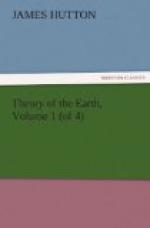The object of inquiry being the operations of the globe, during the time that the present earth was forming at the bottom of the sea, we are now to take a very general view of nature, without descending into those particulars which so often occupy the speculations of naturalists, about the present state of things. We are not at present to enter into any discussion with regard to what are the primary and secondary mountains of the earth; we are not to consider what is the first, and what the last, in those things which now are seen; whatever is most ancient in the strata which we now examine, is supposed to be collecting at the bottom of the sea, during the period concerning which we are now to inquire.
We have already considered those operations which had been necessary in forming our solid land, a body consisting of materials originally deposited at the bottom of the ocean; we are now to investigate the source from whence had come all those materials, from the collection of which the present land is formed; and from knowing the state in which those materials had existed, previously to their entering the composition of our strata, we shall learn something concerning the natural history of this world, while the present earth was forming in the sea.
We have already observed, that all the strata of the earth are composed either from the calcareous relicts of sea animals, or from the collection of such materials as we find upon our shores. At a gross computation, there may perhaps be a fourth part of our solid land, which is composed from the matter that had belonged to those animals. Now, what a multitude of living creatures, what a quantity of animal economy must have been required for producing a body of calcareous matter which is interspersed throughout all the land of the globe, and which certainly forms a very considerable part of that mass! Therefore, in knowing how those animals had lived, or with what they had been fed, we shall have learned a most interesting part of the natural history of this earth; a part which it is necessary to have ascertained, in order to see the former operations of the globe, while preparing the materials of the present land. But, before entering upon this subject, let us examine the other materials of which our land is formed.
Gravel forms a part of those materials which compose our solid land; but gravel is no other than a collection of the fragments of solid stones worn round, or having their angular form destroyed by agitation in water, and the attrition upon each other, or upon similar hard bodies. Consequently, in finding masses of gravel in the composition of our land, we must conclude, that there had existed a former land, on which there had been transacted certain operations of wind and water, similar to those which are natural to the globe at present, and by which new gravel is continually prepared, as well as old gravel consumed or diminished by attrition upon our shores.




